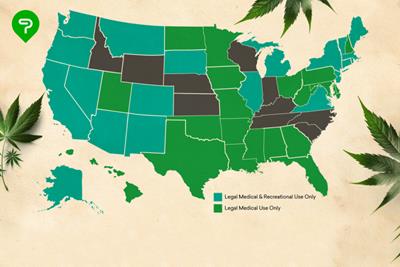
Tuesday February 21, 2017
By Morgan Smith
 News
News
You may have already heard—and celebrated—the news: The November 2016 election brought the passage of California Proposition 64, also known as the Adult Use of Marijuana Act (AUMA), which means recreational marijuana in California will be legal in 2018.
In 2015, California marijuana was responsible for nearly 62% of all medical marijuana sales and 48% of all cannabis sales in the U.S. To put that information into perspective, the cannabis market in California is already larger than states with up-and-running recreational sales like Oregon, Washington & Alaska.
Even new legal markets like Nevada and Massachusetts don't hold a candle to California's cannabis potential. With the recent legislative victory, projections from New Frontier and Arcview Market Research (pdf) show recreational marijuana in California to be valued at $6.5 billion dollars by 2020—a 23.1% compound annual growth rate in state sales. It’s on track to be the largest legal weed market in the country.
How Will Recreational Marijuana in California Work
California is the largest cultivator and producer of cannabis in the country (even larger than Colorado), thanks to its fertile soil. And the state—home to nearly 12% of all Americans—is about to see a serious boom once the new marijuana laws are enacted and the recreational pot market officially opens up for business. So, what exactly does the new legislation do? Prop 64 will:
- Legalize possession and use of up to one ounce of marijuana and personal use cultivation of up to six plants per residence by adults 21 and over
- Reduce penalties for most illegal cultivation, sale, transport and possession of recreational cannabis
- Allow prior offenders to have their criminal records changed to what they would have been if Proposition 64 had been in effect
- Establish a licensed regulation system for commercial production and sale of adult use of cannabis beginning Jan. 1, 2018
The bill also includes legislation for production and excise tax, a plan for how tax revenue will help the state as well as public consumption and license requirements. But for some legislators and their constituents, more needs to be done. At press time, there were nine bills sitting before the California Senate and Assembly. Here are a few:
- Assembly Bill 238 aims to make it illegal for anyone with a state license to distribute marijuana to turn down someone for a job because they aren’t part of a union. It stands to be heard in committee on March 2.
- Senate Bill 148—or the “Cannabis Safe Payment Act”—would enable cannabis businesses to pay state taxes and fees in cash at multiple designated locations around the state.
- Assembly Bill 175 is intended to require edibles companies to submit packaging and labels to the state for approval before introducing marijuana products to the market.
- Assembly Bill 6 would let law enforcement officers start using a roadside saliva test to determine if a driver has consumed marijuana. The technology is controversial but the bill has been referred to the Committee on Public Safety.
Perhaps the most interesting of them all is Assembly Bill 64. Currently pending in the state legislature, this bill would allow California businesses to register their trademarks with the Secretary of State. Currently, the Patent and Trademark Office doesn’t allow the registration due to its illegality under federal law, which is why the state is taking it into its own hands. But there are a few roadblocks to consider amidst the victories and continued efforts.
The passage and implementation of California's Prop 64 and recreational sales also means lawmakers must consider the pre-existing Medical Cannabis Regulation and Safety Act (MCRSA). But the MCRSA and Prop. 64 have different license requirements, timelines, categories and tracking systems.
How New Legislation Will Improve Operations
Currently, medical marijuana licensees may only hold a California license in up to two out of 17 separate license categories—essentially preventing and prohibiting vertical integration (or big businesses from overtaking the market from seed to sale). The new legislation for recreational marijuana in California allows for vertical integration with 19 separate licensing options. This inconsistency could be damaging to small medical cannabis companies and might divide the two markets when it comes to big business and investment opportunities.
Under state law and MCRSA, California operators are required to obtain licenses from both the state and local level. But local jurisdictions can deny licenses, ban outdoor cultivation, impose additional taxes or restrict retail locations. This could lead to a missed economic opportunity for the state and entrepreneurs alike. This is all in addition to the issues surrounding the federal classification of cannabis as a Schedule 1 drug, interstate commerce prohibition and cash management/banking issues.

Recreational marijuana in California is about to boom. Photo credit
One thing is bound to happen, job growth. In an October 2016 report (pdf) commissioned by a marijuana investment company, the University of the Pacific's Center for Business and Policy Research found that roughly 1,600 to 20,000 jobs would be created in the Sacramento region alone. As the industry grows, so will the need for growers, cultivators, manufacturers and entrepreneurs.
Whether you live in The Golden State or not, keep an eye on recreational marijuana in California and its fledgling industry. Its entry into the recreational cannabis marketplace will be something we’ll certainly be paying attention to—and are excited to report on throughout its development.







